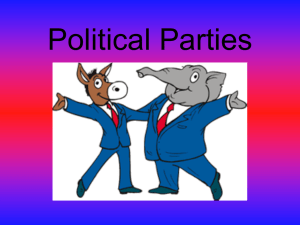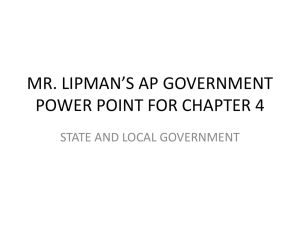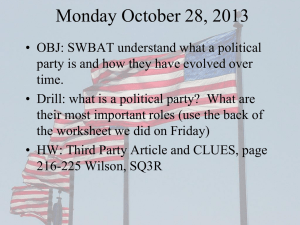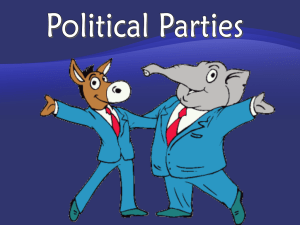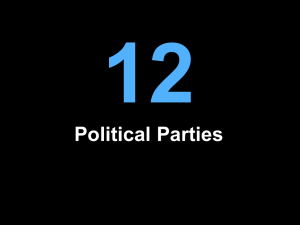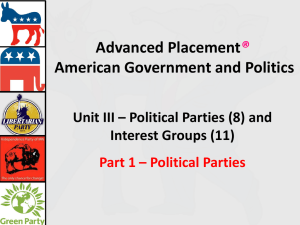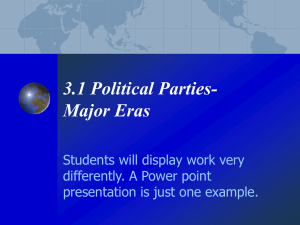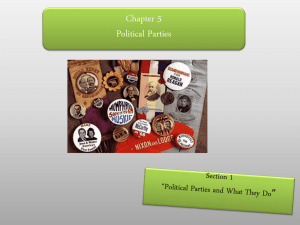Part 2 - StudyHistory.co.uk
advertisement
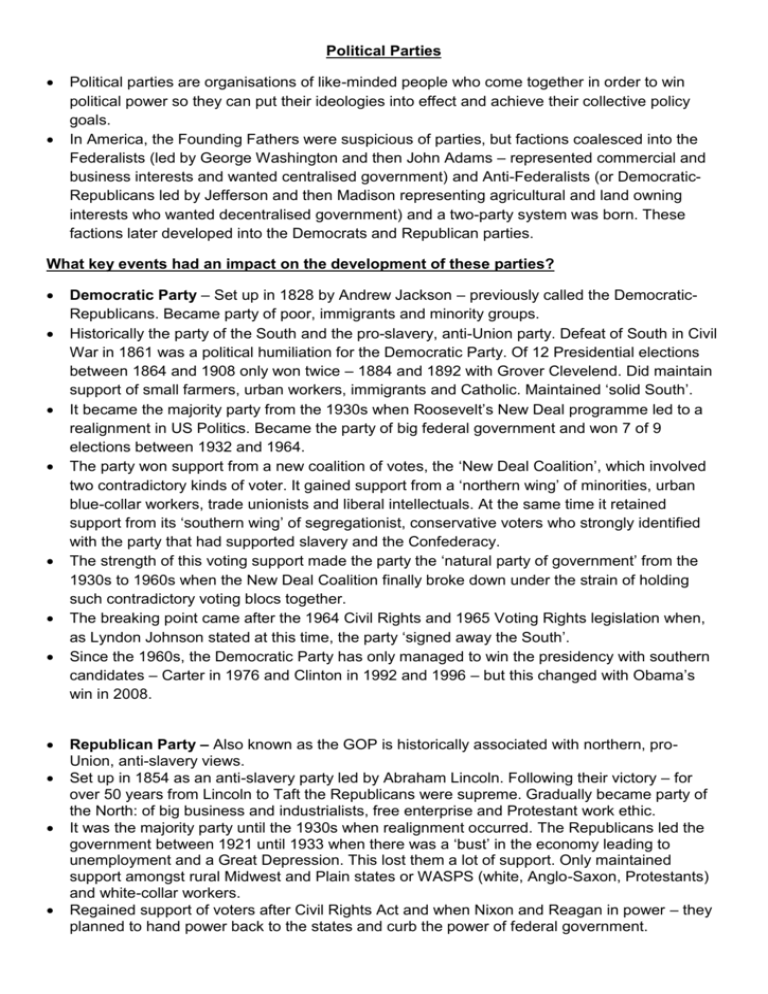
Political Parties Political parties are organisations of like-minded people who come together in order to win political power so they can put their ideologies into effect and achieve their collective policy goals. In America, the Founding Fathers were suspicious of parties, but factions coalesced into the Federalists (led by George Washington and then John Adams – represented commercial and business interests and wanted centralised government) and Anti-Federalists (or DemocraticRepublicans led by Jefferson and then Madison representing agricultural and land owning interests who wanted decentralised government) and a two-party system was born. These factions later developed into the Democrats and Republican parties. What key events had an impact on the development of these parties? Democratic Party – Set up in 1828 by Andrew Jackson – previously called the DemocraticRepublicans. Became party of poor, immigrants and minority groups. Historically the party of the South and the pro-slavery, anti-Union party. Defeat of South in Civil War in 1861 was a political humiliation for the Democratic Party. Of 12 Presidential elections between 1864 and 1908 only won twice – 1884 and 1892 with Grover Clevelend. Did maintain support of small farmers, urban workers, immigrants and Catholic. Maintained ‘solid South’. It became the majority party from the 1930s when Roosevelt’s New Deal programme led to a realignment in US Politics. Became the party of big federal government and won 7 of 9 elections between 1932 and 1964. The party won support from a new coalition of votes, the ‘New Deal Coalition’, which involved two contradictory kinds of voter. It gained support from a ‘northern wing’ of minorities, urban blue-collar workers, trade unionists and liberal intellectuals. At the same time it retained support from its ‘southern wing’ of segregationist, conservative voters who strongly identified with the party that had supported slavery and the Confederacy. The strength of this voting support made the party the ‘natural party of government’ from the 1930s to 1960s when the New Deal Coalition finally broke down under the strain of holding such contradictory voting blocs together. The breaking point came after the 1964 Civil Rights and 1965 Voting Rights legislation when, as Lyndon Johnson stated at this time, the party ‘signed away the South’. Since the 1960s, the Democratic Party has only managed to win the presidency with southern candidates – Carter in 1976 and Clinton in 1992 and 1996 – but this changed with Obama’s win in 2008. Republican Party – Also known as the GOP is historically associated with northern, proUnion, anti-slavery views. Set up in 1854 as an anti-slavery party led by Abraham Lincoln. Following their victory – for over 50 years from Lincoln to Taft the Republicans were supreme. Gradually became party of the North: of big business and industrialists, free enterprise and Protestant work ethic. It was the majority party until the 1930s when realignment occurred. The Republicans led the government between 1921 until 1933 when there was a ‘bust’ in the economy leading to unemployment and a Great Depression. This lost them a lot of support. Only maintained support amongst rural Midwest and Plain states or WASPS (white, Anglo-Saxon, Protestants) and white-collar workers. Regained support of voters after Civil Rights Act and when Nixon and Reagan in power – they planned to hand power back to the states and curb the power of federal government. It became the minority party in Congress until the 1994 mid-term elections and Newt Gingrich’s ‘Contract with America’ which gave the GOP a majority in the House and Senate, lasting until 2006. The party was successful in winning presidential elections (with a southern strategy) with Nixon winning in 1968 and 72, Reagan in 1980 and 1984, George H. W. Bush in 1988 and George W. Bush in 2004 and 2004. Seemed to be slight change in policy with Bush in power (2001-2009) and he saw a significant rise in the size and scale of federal government in foreign policy but also education. Criticised by his own party. In what ways are the two main parties similar? Party names suggest similar – both believe in Republic and democracy. Agree on the Constitution and the political system it created Agree on a capitalist economic system with commitment to private enterprise and free marks. The ‘dominant ideology’ in the USA with commitment to individualism, liberty, equality and the American Dream. Described as pragmatic, ‘big tent’, catch-all internal coalitions whose aim at elections is to maximise their vote in order to gain office rather than to put into practice an ideological blueprint. They both operate in the middle ground of politics, rarely straying out of this comfort zone. When conservative Republic Goldwater in 1964 and very liberal Democrat McGovern in 1972 strayed from the mainstream they were defeated. Some say the parties give ‘fudged’ positions without giving a clear choice to voters – suggesting they want to get into government rather than offering a clear policy programme. Professor Brogan said they were ‘like two bottles with different labels, both empty’ and Professor Rossiter said ‘They are creatures of compromise, coalitions of interest in which principle is muted and often silenced’. In 1972 44% said there were no differences between the parties and only 46% said yes. In what ways are the two main parties different? Both parties remain ‘big tent’ internal coalition, although are distinct from one another and more united internally than were in the past. Both have wide spectrum of ideological beliefs with more ‘conservative’ ‘liberal’ and ‘moderate’ members in each party. Different depending on state, region or area. South tends to be more conservative, the Northeast and west coast more liberal. Are economic conservatives and liberals, social conservatives and liberals, hawks and doves, isolationists and internationalists within each party. People gradually began to see them as more distinct – only 55% thought they were different in 1964 compared to 76% in 2004. The Democratic Party More liberal party Economic intervention and a more activist government role in regulating and managing the economy in the interests of all the people. The introduction and development of social The Republican Party More ideologically conservative party. Committed to free market economy as free as possible from government intervention and regulation, and supports a less active, more limited government role. Fiscally conservative, committed to lower welfare programmes such as Medicare/Medicaid in healthcare to promote equality. Equal rights programmes such as civil rights, women’s rights and gay rights. Commitment to federal rather than state government action. A more ‘dovish’ foreign policy, internationalist in seeking diplomatic solutions to problems. A more pro-choice stance on abortion and more in favour of gun control. taxes, lower spending (with the exception of defence) and balanced budgets. It believes the private rather than the public sector should provide employment, health and welfare (although it supports Medicare, thought to be ‘untouchable’ because the elderly vote in large numbers). It does not support interventionist programmes to increase the rights of minority groups: its individualistic, self-help philosophy opposes the use of legislation as a way of ‘artificially’ creating equality. It is supportive of traditional family values and social and cultural conservatism. It is more ‘hawkish’ on foreign policy issues, committed to high defence and the use of power to defend American interests. It is more committed to states’ rights and the decentralisation of power It takes a more pro-life position on abortion and is against gun control. LOOK AT THE WORK YOU DID ON THE TWO MAIN PARTIES POLICIES ON THEIR WEBSITES AND HOW SIMILAR OR DIFFERENT THEY WERE. Who are the main supporters of each party? Typical Democrat supporters Blue-collar workers, trade unionists and less affluent public sector workers attracted by its economic views. Minorities attracted by its commitment to equal rights. City dwellers in ‘blue states’. Intellectuals and radicals attracted to its liberal agenda. A majority of female voters in recent elections. Typical Republican supporters Business and corporate interests Higher-income voters White voters Rural, small-town and suburban voters in ‘red’ states. Religious groups, especially Protestants and evangelicals. What are the main divisions in the Democratic Party? Southern, conservative wing (congressional wing of the party); Democrats from southern states and their elected representatives holding conservative views on all issues, economic, social and foreign, and never reliable Democrat voters in Congress. Northeastern, liberal wing (presidential wing of the party) allowed Republican party to paint Democrats as tax-and-spend party supporting minorities and liberal causes. ‘New Democrats’ associated with Bill Clinton, Al Gore and Democratic Leadership Council who were ‘modernisers’ of Democratic Party who wanted to win back blue-collar and southern voters by moving away from tax-and-spend image and won back presidency in 1992 and 1996. Clinton said ‘the era of big government is over’ as tried to move party back towards the middle. What are the main divisions in the Republican Party? Traditionally the Republican Party was less factionalised than the Democrats, but during the Reagan presidency ideological divisions grew between the more moderate and more conservative wings of the party. The ‘Wall Street’ wing – Moderate, fiscally conservative but socially liberal Republicans, mainly from northeastern states, representing business and corporate interests, thee ‘compassionate conservatives’ of the party. The ‘Main Street’ wing – More conservative Republicans from rural, suburban and small-own America, supporting traditional family values and strongly anti-Communist. 1980s saw emergence of the religious, radical right or New Right (neo-conservative) conviction style-politics associated with Reagan. Believe in fiscal conservatism and strong commitment to small government, free markets and deregulation (Reagan said ‘Government is the problem, not the solution’, a more hawkish foreign policy, high defence spending, greater focus on social conservatism on anti-abortion, pro-school prayers policy and strong support family values. Led to support from white voters in the South as since 1980 a majority of white southerners have identified and voted with the Republican Party. Also, attracted the ‘Reagan Democrats’: the blue –collar ‘Joe-Six Pack’ workers in the industrial states who switched to the Republican party because of its more conservative position. Party became more united over ‘Contract with America’ and highly conservative platform of ideas. Party won back presidency in 2000 and 2004 focusing on conservative agenda based on ‘Guns, Gays and God’ and ‘Faith, Flag and Family’. Conservative wing has been ideologically dominant in Congress and party base highly conservative. Forced to reconsider in 2008 with demise of successful ‘Reagan Coalition’ and led to fractures over moderate and conservative ideological lines. LOOK AT YOUR BREAKDOWN OF THE FACTIONS IN BOTH THE DEMOCRATIC AND REPUBLICAN PARTY AND WHAT THEY EACH BELIEVE IN. How has the Democratic Party changed? Previously been old-fashioned liberal Democrats and New Democrats. Many saw defeats in 1968, 72, 84 and 88 as showing old-style liberal candidates were not succeeding – Humphrey, McGovern, Mondale and Dukakis all defeated. Led to setting up of Democratic Leadership Council (DLC) who aimed to move Democrats nearer to centre with Clinton as candidate. However, some question how much he changed as Al Gore did not try and follow these beliefs and in 2004 Kerry was chosen who was an old-style Democrat. Then in 2008 Obama was the most liberal member of the US senate showing not towards the centre. Firs liberal Democrat to win since 1960. How has the Republican Party changed? In 1960s seen to be fight between conservatives (led by Goldwater) and moderate Rockefeller. Battle seen in every election – in 1976 moderates had upper hand as Ford beat Reagan but Reagan triumphed as a more conservative in 1980 and 1984. Reagan was clearly more ideological and wooed conservatives away from the Democratic Party and made it uncomfortable for moderates. Bush won in 1988 who was seen as more moderate. Bush then tried to blur these ideological issues with his ‘compassionate conservative’ to appeal to both moderates and Conservatives. Cabinets reflect the divisions within the party with mixtures of conservatives and moderates. It was noted that Bush ended up tending to look more conservative than compassionate and his cabinet increasingly included conservative members. LOOK AT BREAKDOWN OF FACTIONS OF DEMOCRATIC AND REPUBLICAN PARTY AND YOUR NOTES ON THIS How polarised is American politics? What was the situation in 1960? In 1960 ‘Solid South’ intact with all voting for Democrats – described themselves as ‘yellow dog Democrats’ meaning they would elect anything as long as they were democrat. 1960 election of 106 House of Representatives from South: 99 were Democrat, all 22 Senators and 11 Governors were Democrats. Kennedy won eight of the 11 southern states. However, between 1964 to 2000 and next ten presidential elections – Democrats only won majority of the South on one occasion in 1976 when southerner Carter was challenging. However, 1992 and 1996 even with a southern candidate they did not get a majority. Why did it change? Prompted by Civil Rights Act - In 1964 south supported conservative Republican candidate, Goldwater and six major states changed support. In 1968 five southern states voted for ultraconservative Democrat Wallace as a third party candidate – rather than voting for own Democrat candidate Humphrey. Nixon launched ‘southern strategy’ while in power to attract ex-Democrat voters with promise of policies and appointments more to their liking. Said Republicans had more to offer people than Democrats. In 12 years Nixon doubled Republican vote in Georgia and Louisiana and tripled it in Mississippi. Made a clean sweep of all 11 southern states in 1972. In 1980 Reagan won 10 of the 11 southern states and in space of twenty years had increased seats in House of Representatives from seven seats to 39, in Senate from 0 to 10 and 5 governors rather than 0. Shown in 1992 as all-southern Democrat ticket of Clinton-Gore lost 7 of 11 southern states to Bush and in 1994 Republicans gained majority status in House, Senate and governors in the South. Controlled 64 House seats to Democrats 61, 13 Senate to Democrats 9 and six governors to Democrats 5. Some recovery in 2008 as Obama won presidential and senate races in Virginia and North Carolina – picked up ten House seats and three Senate seats in the South. What impact did the changes have? Led to two major parties becoming more ideologically distinct. Conservative voters crossed from Democratic Party and joined Republicans – made Republicans more conservative and Democratic Party more left wing. Significant members of the Democrat party liked Thurmond and Gramm switched to the Republican party. Led to development of ‘Solid Northeast’ – no Republican House members in any of six New England states and only 17 Republicans in whole Northeast – other 76 are Democrats. Of 22 Senators 18 are Democrats and 4 Republicans. Of 11 governors – 8 are Democrats. Of 22 state legislative chambers 21 are controlled by Democrats. What other factors caused polarisation? End of cold war – need for unity in face of threat had gone. Reagan attracted more conservative Democrats but pushed away more liberal Republicans. Clinton (even though he was a New Democrat) caused a bigger divide between the parties by looking at issues such as role of women, abortion, morality an sex. Bush also proved to be a divisive president – arguments over how he was elected in 2000 and military operation in Iraq caused divides. Technology enabled people to communicate with each other more effectively and newspapers, journals, network, journals – tune in or log on to those media sources which reinforce their existing views. Increased partisanship. Is the USA a ’50-50 nation’ with a ‘red v. blue divide’? Focused on due to result of 2000 election. Both candidates ended up with 49% of vote, Electoral College 271-267, House of Representatives 221-212 with Senate split 50-50. 2004 swung slightly Republican – 51-48% in popular vote, 286-252 in Electoral College, 232202 in House, 55-45 in Senate. Only three states changed hand in election and these states changed sides so they conformed more to the patterns around them – New Mexico turning Republican and New Hampshire moved Democrat. ‘Red America’ seen to be more male, white, Protestant, wealthy, rural or suburban and conservative. ‘Blue America’ more female, white, black, Asian and Hispanic, not that religious, less wealthy, mainly urban and definitely liberal. Less clear cut in 2008 with nine states that had voted Republican in 2004 voting for Obama (including Indiana which Bush had won by 21% points in 2004). Some states less clear – West Virginia would be expected to be Republican but has Democrat senators and Congress members. Even Massachusetts, New York and California which are liberal have had Republican governors. Voting in congress suggest less clear divide – 2008 53% of House and 52% of Senate voted a long party lines compared to 73% in House and 69% in Senate in 1995. How are the main parties organised? National committees – DNC and RNC. Both have offices in Washington DC. Both have chairman but rarely heard of. Organise National Conventions every four years. Do agree rules for holding state-based presidential primaries and caucuses. Congressional committees - Oversee policy and campaigning. State-level organisation – Variety of organisations, laws and customs with power given to state governors and mayors In comparison with European parties the US political parties are weak, decentralised structures. Because the executive and legislature are separate branches of government, elected separately under different mandates and designed to check each other’s power; this impedes the development of strong party ties both within and between the institutions. Under a federal system, parties are organised at state level, under state law, with little control by their national committees. This means that parties and their candidates differ widely across the 50 states. In this sense, there are effectively 50 Democratic and 50 Republican parties with a ‘bottom-up’ rather than ‘top-down’ organisation. They have no mass membership (though voters can register as Democrat or Republican). There are no party leaders as such. The president is the leader of the country rather than his or her party, and there is congressional leadership only through the speaker of the House and the Majority and Minority Leaders. The post of leader of the opposition does not exist. There are no party manifestos, only ‘platforms’ decided at the conventions. Candidates for congressional and state office stand on their own personal views, and focus on local rather than national issues. The finance that candidates need in order to run for office is raised mainly by the candidates, not their parties. Candidates for office are selected by primaries and caucuses rather than by the party. They can only be removed by the electorate at the next election, or through primary defeat, and cannot be deselected by their parties. In electoral campaigns candidates rarely mention their party, but they key gift of the parties to their candidates is the label of either ‘Democrat’ or ‘Republican. This is cue for aligned voters to turn out for candidates. When individuals are elected to office they tend to vote the way they want, now how the party tells them to. In Congress there is little party discipline to control their voting. To what extent is the party over? Evidence that the party is over David Broder wrote his thesis that ‘the party is over’. Said changes in political environment had led to changes in parties traditional functions of selecting and funding candidates and running campaign. Until 1960s parties selected candidates through machine politics and party bosses, but this has changed with the more widespread use of primary elections, where candidates are chosen by voters, not by the party. Candidates now create personal organisations to appeal to voters and put across their personal views on issues. These intra-party contests weaken parties as candidates fight each other for nomination. In most democracies, parties fund their candidates seeking election. In the USA, candidates raise ‘hard money’ contributions, gain funding from political action committees, or accept federal funding for presidential elections. This funding goes to the candidate, not the party, which reduces the party’s organisational role in the campaign. Candidates now reach out to voters through the mass media and political advertising that focuses on the candidate and their image. Media campaigns strengthen candidate identification and weaken party identification, as they stress the characteristics of the Evidence of party resurgence Ideological Republican Party is now more ideologically cohesive as a fiscally and socially conservative party. Karl Rove’s strategy for Bush in 2004 was to energise the base of ‘value voters’ in order to get the core conservatives voters out to the polls. Seen in current voting over Jobs Plan and Tax Plan – preventing certain changes and voting as a unit. The Democratic Party is now more cohesive and offers a clear alternative to the Republican Party, appealing to voters as a party of liberal values and policies, as seen in the 2008 campaign. Ideological cohesion is reflected in congressional voting, with greater party unity and partisanship on issues. For example, Republicans were encouraged to vote together to support Bush’s agenda after 2000 and the Democrats have shown greater party unity in votes in the House of Representatives under the leadership of Nancy Pelosi. Republican Party in 1994 campaigned around ten-point policy and promised votes be held on ten policy issues of interest to conservative voters – looking at balanced budget and congressional term limits. candidate and play down the party. US politics is now more characterised by pressure groups focusing on single issues such as abortion or the environment than by party politics. Reduced attachment of voters to parties can lead to split-ticket voting, voters switching between parties, and higher abstention. Candidates make personal appeals to these voters to gain votes. Parties lost function as communicator between politicians and votes and vice versa. Communicate through television which voters ‘speak back’ through opinion polls. Role of party cut out. Increase in split-ticket voting – voting for candidates of different parties for different offices at the same election. Fuelled theories of voting decline. Increase is partisanship – 1995 recorded votes in senate showed partisanship and grew during impeachment and trial of Clinton. Votes largely across party lines. Organisationally The parties’ national committees and chairs play an increasingly important role between elections, as well as organising the national conventions every 4 years. National party campaigning strategies have been created to elect the president and members of Congress and state legislatures. This involves the national party structures having some control over the direction and focus of the campaigns and how the parties’ resources are targeted. The role of the Democratic Party’s superdelegates at the national convention could be important if there is a tie in the delegate count. Parties have modernised structure and networks – Republicans passed Brock reforms strengthening National Committee. 1990s Democratic National Committee Manatt developed computerised direct-mail facilities and permanent headquarters. Soft money in 1980s and 1990s meant parties utilised fact that funds for ‘party building’ and get out the vote activities were led by the party. Enhanced party role in campaigns. The Democratic National Committee declined to seat the Florida and Michigan delegations at the 2008 convention because of their refusals to follow party rules in conducting state primaries. Both national committees now channel political donations to candidates in tight races and can withdraw finance from candidates they do not approve of. May be case that both parties have change their role and functions are different to what they were in the 1950s and 60s. Both still strong and active Other parties have made no significant inroads into their support. The majority of voters still identify with them Very rare for any candidate to be elected without belonging to one of them To what extent does the USA have a two-party system? Despite huge social, economic, regional and ethnic diversity, it has only two parties competing for political office at all levels in all branches of government. Led to a duopoly since beginning of Republic and regarded as a paradox as so many deep divisions in the population. Does the USA have a two-party system? The last 11 presidential elections between 1968 and 2008, the Democrats and Republicans accounted for more than 80% of the popular vote on every occasions. In seven of these 11 elections they gained 95%. Only in 1968 did the Democrats and Republicans fail to win all the Electoral College Votes. Following the 2008 election – only two members of the Senate Sanders and Lieberman were not sitting as either Democrats of Republicans. Although, Sanders is mainly Democrat and is never rivalled by the Democratic party. Lieberman has been elected to the Senate four times as a Democrat before running as an independent. Every President since 1853 has either been a Democrat or Republican. In congressional elections, the use of the winner-takes-all system in single-member districts and states leads to two-party dominance, as votes for second and third parties are always wasted. In presidential elections, voters vote for a single executive through the Electoral College. There can only be one winner, with no possibility of power-sharing in the presidency. There is nothing for the losers, no matter how many votes they gained. The ‘big tent’ internal coalition nature of US parties and their habit of political ‘clothes-stealing’ (adopting popular policies put forward by their rivals) leaves little ideological or issue space for third parties to fill that is not already covered by the two main parties. The party identification of most voters with the two main parties is strong, and it is difficult to establish new alignments. On most issues there are two opposing viewpoints: for or against, left or right, liberal or conservative, and therefore there is a tendency for voters to fall into one of two camps: Democrat or Republican. People focused on single issues tend to form pressure groups to get their views and interest represented, rather than establishing new parties to contest elections. If individuals oppose what party candidates do they can challenge them in primaries. This gives voter a choice within the party, rather than requiring the formation of an alternative party. In what ways is the US system not a two party system? There is effectively a four-party system with both parties divided into liberal and conservative wings. There is a 100-party system with different Republican and Democratic parties in each of the 50 states. Parties are undisciplined, decentralised, state-based parties with no national leader and policy programme. There are several one-party regions where one of the parties is dominant. Some say the parties have become so ideologically indistinct that they have similar policies – Clinton talked about ‘the era of big government’ being over and a Republican president added a new department to the government – comparing them to ‘Tweedledum and Tweedlee’ who are the same but arguing over image. Shields stated ‘As of today, the country has two Republican parties, separated by the issue of abortion’. What third parties exist? Different types: national, regional and state-based, permanent and temporary, issues-based and ideological. Best known are the Reform Party; Libertarian Party (who Gary Johnson is rumoured to be standing for in the upcoming election) and the Green Party (these three had candidates on the ballot in all 50 states in the 2000 presidential election). Also, regional such as Thurmond’s States Rights Party and Wallace’s American Independent Party. No national, permanent third parties that regularly win a sizeable proportion of the us votes in general election. Unimportant as combined popular vote in 2008 was less than 1% but important as in five of nine presidential elections between 1968 and 2000, a third party played a significant role and it could be argued they decided the outcome. E.g. George Wallace for American Independent Party in 1968– gained 13.5% of vote and split Democrat vote leading to Republican Party John Anderson for National Unity Party in 1980 – gained 7% and took votes from Democrats. Ross Perot as an Independent in 1992– 19% of vote and took votes from Republicans leading to Democrat victory. Ross Perot in 1996 for the Reform Party – 9% took votes mainly from Republicans. Ralph Nader in 2000 for the Green party – 2.7% took votes from Democrats leading to Republican victory. Results from 2008 Third Parties PLEASE LOOK AT YOUR FACTFILES YOU PRODUCED AND GAVE EACH OTHER ON THIRD PARTIES AND THEIR DEVELOPMENT Why are third parties not successful? Third parties face barriers in many states, such as electoral laws which require them to gather thousands of signatures before they can get onto the ballot. Tennessee requires just 25 signatures whereas New York must get signatures in every county while California need 1% of the electorate. It is challenging to do this in every state. Must spend much of hard-earned cash on ballot access petitions rather than on real campaigning. Federal funding is given to Democrats and Republicans, but other parties only get funding if they gained 5% of the vote at the previous election. It is difficult to secure alternative sources of finance, since organisations such as political action committees want to fund winners, not losers. Very few third parties achieve this – only Wallace (1968), Anderson (1980) and Perot (1992 and 1996) have managed it. Lack of funding means less effective campaigns. Third-party candidates find it difficult to secure media attention and coverage of their issues, and consequently struggle to achieve name recognition or national awareness. They are usually excluded from the debates and lack electoral machines to persuade their supporters to turn out to vote. Tend to suffer from a lack of well-known and well-qualified candidates and hard to attract suitable running mate. Often portrayed as ideological extremists by two major parties. George Wallace was compared to Hitler and great fear of political extremism due to ‘red scares’. The electoral system is a first past-the-post winner takes all system. This makes life difficult for third parties. Regional third parties can do well where votes are concentrated but it makes it hard for national parties where support is spread out. What evidence is there of third party success? Have been some significant third parties and independent candidates in US elections. Some argue that Nader’s candidacy in 2000, when he gained 2.7% of the vote, was a factor in Gore’s defeat as he took away votes in key states such as Florida, thus handing the election to Bush. In Florida where Bush won by just 537 votes, Nader polled nearly 100,000. New Hampshire where Bush won by 7,000 votes, Nader gained 22,000. Perot’s 19% of the vote in 1992 was a factor in George H. W. Bush’s defeat and his platform of deficit reduction influenced both parties to adopt this position in 1996 election. George Wallace’s 1968 candidacy, when he won 46 Electoral College votes from five southern states, could have deadlocked the Electoral College. Most votes received by third parties are protest votes against the two main parties. Third parties have some importance within the electoral system, bringing new ideas onto the political agenda, acting as critics of the two main parties and offering a greater choice to voters. Influential in 2008 although overall result unaffected – Missouri McCain won by 1,600 but Nader got 18,000 votes and Barr as Libertarian party got over 11,000. In Indiana, McCain lost by 26,000 votes and Barr gained 29,189 votes. In North Carolina McCain lost by 13,692 votes and Barr got 25,419. In 2008 congressional races, third party candidates bit-part players. Only exception was senate race in Minnesota – Dean Barkley (Minnesota Independence Party) gained over 15% of the vote and led to defeat Republican senator Coleman. However, none come near to breaking mould of American two-party politics or making electoral breakthrough. Can never hold balance of power and described of ‘bees of American politics’ – stringing briefly and then dying, remaining confined to the margins of US politics. LOOK AT YOUR ABLE ON THIS TOPIC FOR THE SYNOPTIC ELEMENT – ANY AREAS YOU WERE NOT SURE ABOUT PLEASE EMAIL AND ASK ME
